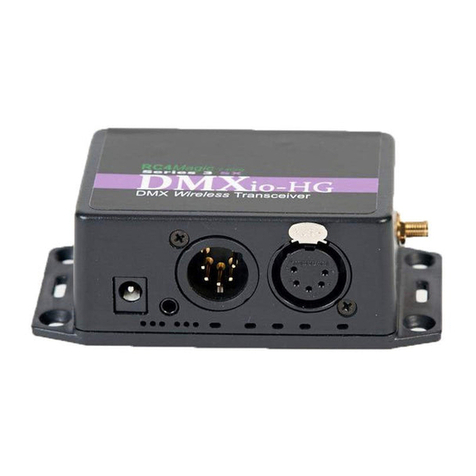Data Cabling
Power supply ground is NOT connected to data ground within the RC5 EASS IP65 transceiver. A connection
screw for an AC power ground wire is provided, which affects only the area surrounding the power supply
section of the circuit board, outlined with white lines on the circuit board.
To avoid ground loops, particularly with long data cable distances, avoid connecting power and data ground
together at the transceiver. Allow the transceiver electronics to float to the ground potential of the data line.
DMX connections can be made via screw terminals or RJ45 connectors. Pin-out information is provided on
the circuit board, immediately adjacent to the connectors. The RJ45 pin-out complies with the ESTA standard
for DMX over RJ45.
To avoid data errors or data loss, low-capacitance cable must be used. Consult the following standards
for details on appropriate cable for DMX data transmission, and DMX over RJ45:
● USITT DMX512/1990 Digital Data Transmission Standard for Dimmers and Controllers
● ESTA / ANSI E1.11 - 2004 Asynchronous Serial Digital Data Transmission Standard for Controlling
Lighting Equipment and Accessories
Antenna Positioning and Orientation
RC5 transceivers should be positioned for the shortest possible distance between antennas with the fewest
obstacles in the line-of-sight path between antennas. Omnidirectional antennas, sometimes called whip
antennas, should be oriented vertically, with the tip pointing directly upward or downward. For other types of
antennas, follow instructions provided with them.
Higher elevation of antennas improves range. This is particularly true of the transmitter antenna.
When assembling a wireless DMX system consisting of multiple receivers, try to position the transmitter in the
center of the geographical service area, ensuring the shortest possible distances to all receivers. This is
preferred to placing the transmitter at one end of a line, or at the edge of a circle of devices. Nonetheless,
RC4 Wireless acknowledges that it is not always possible to position the transmitter centrally.
Required Tools and Equipment for Installation and Maintenance
You need the following tools and equipment to install an RC5 EASS IP65 transceiver:
● ESD-preventive cord and wrist strap.
● Electrical wiring tools commonly used by commercial electricians.
● Appropriate tools for mounting the enclosure to the wall material at the installation site.
Warning: Only trained and qualified personnel should be allowed to install, replace, or service
RC4 Wireless equipment and other devices connected to RC4 Wireless equipment.




























